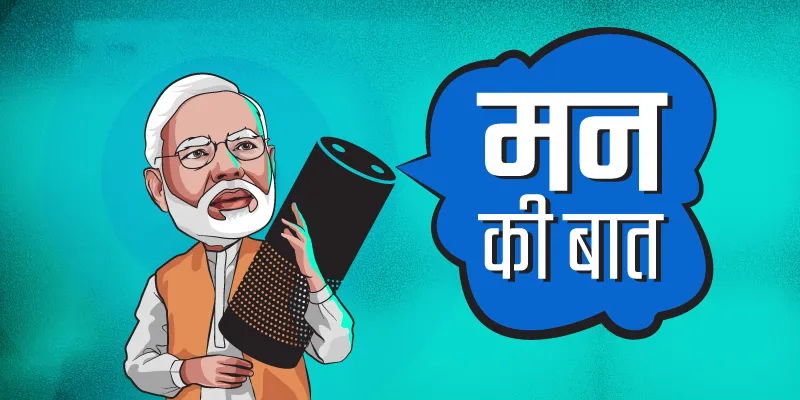‘Alexa is your friend - talk to her about anything’ – Amazon Echo country head speaks on localisation, Indianising devices
One of the challenges global tech companies face in India is localisation. Amazon ecommerce succeeded because it spoke to consumers in a language they understood. Now, with the Echo products, it has a new set of challenges.
Amazon Echo was the first — and only — smart speaker in the market back in 2016. The product was restricted to the US, and later launched in the UK and Germany.
Amazon’s early-mover advantage allowed it to take a significant lead over peers Google and Apple, which launched their own voice-enabled speakers much later. As a result, Amazon Echo now owns two-thirds of the worldwide smart speaker market, according to eMarketer.
Last October, the Amazon Devices team turned its attention to India.
It launched the Echo, Echo Dot, and Echo Plus to select customers, and allowed them to purchase the devices on an invite-only basis. This was followed by a general rollout in February. In April, Amazon added a fourth device — the Echo Spot — to the lineup. There could be more coming.
Between then and now, Amazon claims to have sold “tens of thousands of” Echo devices in India — its fourth launch market. Precise numbers are hard to come by given Amazon’s stringent policies, but it is clear that Echo and Alexa (the AI-powered voice assistant which forms the core of the device) have worked well here.
Amazon is laser-focused on making Echo “as Indian as possible”. It is doing several things to ensure that Indian customers do not dismiss the device as “just another American object”. As customers interact more and more with Alexa, it helps Amazon develop ‘skills’ based on the utterances (things people ask).

In a conversation with YourStory, Puneesh Kumar, Country Manager – India, Alexa Experiences and Devices at Amazon, describes the quirks of the Indian market, the enormous language diversity that is helping expand Alexa skills, and how customers themselves are making Echo more Indian.
Edited excerpts:
YourStory: What went into launching Echo in India?
Puneesh Kumar: When we launched Echo in India, it was a first of many kinds. It was the first time that we were entering a country where there were so many languages and so much diversity. We were very aware that enabling the device in English only was not going to cut with customers.
So, we spent a lot of time and effort thinking about all the nuances that make India different, and how we could come up with an Echo device that was relevant to the country. We wanted to ensure that Echo feels Indian to the customer, and is not something that makes them think that an American device has been brought in.
We spent time on the voice, the intonations, the phonemes and pronunciations because voice is the primary interface here. If I say ‘Lata Mangeshkar’ and Alexa does not know who or what it is, that just fails. If I say ‘Zindagi Na Milegi Dobara’, and Alexa cannot understand those four Hindi words, then I cannot play music in India.
We clearly recognised that, and started seeing how we could cede Alexa with the understanding of various proper nouns, ie names of people, places, movies, artistes, songs, across languages. Those are the things people use in everyday language. So, we looked at the customer and walked backwards.
But the list was infinite. We realised we cannot do this on our own. We need the help of people to cede this. As a result, we took a decision to go invite-only. Even before invite-only for customers, we ran it on employee beta where thousands of people at Amazon were interacting with the device. As a result, we got a lot of utterances. We understood what people asked for, what names they looked for, how they pronounced words, and so on.
That helped build a diversity of understanding for multiple languages and accents and we decided to expand it to external customers who could be early adopters and help Alexa become more intelligent.
YS: Between the invite-only phase and general rollout, what was the uptake like? What were Indians doing with their Echo devices?
PK: We were surprised by how enthusiastic people were, how much they appreciated what Alexa was able to do and how fast she could learn based on utterances. In October, Alexa didn’t understand many things. But, in November and December, customers saw she was getting a lot better. Because Alexa is sitting on the cloud, it’s constantly getting better with Machine Learning and Artificial Intelligence algorithms. The more people talked to it, the better it got. We got millions and millions of utterances from October to February, which helped us make the tools and systems really robust. That is when we went ahead and launched it for all on February 15.

YS: What has been the adoption so far? What is the demographic spread?
PK: We got our first external customer in the first week of November. By the end of the year, we had tens of thousands of customers who were interacting with the device spanning all regions and areas of India. From J&K to Kanyakumari, and all the way to Port Blair, we had Echo customers. Tier I, Tier II, metro and non-metro areas - were buying it.
YS: What are the channels through which Echo is being sold in India?
PK: Our initial efforts were towards online sales. Once we got to a real confidence level where the product, the language and the understanding were good enough, we opened it up to offline channels, and the response has been fantastic so far. Our offline partners include big stores like Croma, Reliance Digital, Vijay Sales, Crossword, and more. We also have places where customers can go and interact with the Echo devices. We started with the top 20 cities, and now Echo products are available in 350 offline stores.
YS: Which is the best-selling Echo device here? Are Indians more likely to buy the Echo Dot that is attractively priced?
PK: We see all three products have had a good uptake. People are very familiar with the devices and had been waiting for them to be in India. They are very clear that they want the Echo Plus to control their smart home devices and accessories. Some want an Echo Dot in the living room. People have their own choices around it.
Yes, from an affordability standpoint, the Dot is our entry-level device, which gets you started. So, people who were a little sceptical, yet wanted to try it out, started with the Dot. With the Echo Plus, we had a lot of deals going on with Philips and Syska Bulbs and so on. So, customers who wanted to control room lighting opted for that.
We internally track customer feedback on all devices. All three have more than a 4-star rating, which is fantastic. It means customers are liking engaging with the devices.
YS: Have customers upgraded their entry-level Echos? How are you increasing adoption?
PK: Yes, customers have recorded multi-room usage. Some have more than one device registered in their account. That’s a significant number and it’s growing. We have given as many options to customers as possible. They are not restricted to using Alexa only on Amazon devices. They can use it with any of the AVS (Alexa Voice Service) devices. It allows customers to not have to make huge investments for one device type.
So, for instance, customers who already have a powerful home theatre and surround sound system, and want to enable voice, they can do that. If they are price-conscious, they can use the Echo Dot which allows them to connect the device to their home theatre through Bluetooth or an AUX cable.
Our aim is not to make people buy all of our devices. Our aim is to make Alexa a part of everyone’s life. They can use it in any form that is convenient. Devices are just one part of the medium.
YS: What took the Echo Spot longer to come to India? What is the traction it is getting?
PK: There is a lot that goes into launching a product in a particular country. The other three devices helped us get started.
The multi-modal, or screen devices, like Echo Spot add their own layer of complexity because there are UI elements to it. There is rendering that needs more localisation efforts.
If we had to get everything out there together, we would have delayed the launch for all of them. So, we decided to start working with customers with three devices. The Echo Spot was a fast follow-up which we launched in April. That’s been doing great too. Customers are enjoying and appreciating the screen because that is what they are most used to. It is helping them transition from a Graphical User Interface (GUI) to a Voice User Interface (VUI).

YS: What have been the popular usages of the Echo Spot screen?
PK: Popular usages tend to be watching videos, seeing the flash briefing, and so on. The device has a screen, which even when idle, can be configured to show you the top trending stories, or tips on what to do with Alexa, etc. There are games you can play. You can ask Alexa about stock prices.
It comes with a camera, which is being used to video message or video call. We see a large percentage of people trying out that capability. They feel it adds a whole layer of personalisation and interactivity to the device. In India, we are very used to typing and clicking. But, the elderly might find that difficult. Here, all they have to say is ‘Alexa, accept call’. So, the convenience and seamlessness of the Echo Spot is being appreciated.
YS: Does it mean that voice is removing age barriers and making devices more accessible? Is that where we are headed?
PK: Completely, and on both ends of the spectrum — kids as well as the elderly. For kids, there is an element where they may not know how to read or write. But, they are sharp. They know what and where to click on a smartphone. What is very natural to them is talking. They don’t have to keep navigating through the device. So, the barrier of using technology and internet is going away. It is the same for the elderly. They are not used to the smartphone revolution and they tend to stay away. Now, they don’t need to. They can just say, ‘Alexa, book a cab’.
YS: What are the languages in which Indians are engaging with Echo devices?
PK: There is no clean language split that we see.
People are using Alexa in multiple languages at the same time and even on the same device. Utterances are multilingual because our homes are multilingual.
YS: How is the overall voice-enabled device market shaping up in India, now that there are more players here? How does Alexa plan to stay ahead?
PK: There is a lot of innovation happening in the space, which is great for customers. This is a niche field in tech. So, the more people are aware of voice assistants and their capabilities, the better.
There’s a big awareness-building opportunity we have. We are constantly looking at new experiences, ways to reduce friction (utterances which are failing on Alexa), and steps to deliver customers the experiences they want. We also don’t want to be overtly robotic in our answers.
There are instances when Alexa may not know the answer to something. We are looking at a variety of resources that can help it offer appropriate responses to the things asked. We are working on building the knowledge that Alexa is constantly growing. We launched with 10,000 skills in India, and now we are at 15,000.
There are unique experiences and voice apps being built by thousands of developers, including college students. For the device to be truly functional and utilitarian, you don’t have to wait for Amazon to innovate. We have the Alexa skill kit easily available and that can be used by anyone to offer whatever experience they want.

YS: In terms of consumption, how is India different from other markets if we were to leave the language diversity aside?
PK: It’s hard to compare apples and oranges because it’s still early days in India. The market is where the US was a couple of years ago.
What is promising for us is that the utterances we are getting from customers in India is one of the highest worldwide. It tells us that they are really enjoying interacting with the device and are trying out talking a lot more with it. It means we have a good product.
YS: How critical is the Devices division to Amazon India’s overall operations? Where does Echo want to reach in about a year’s time?
PK: Devices is important. We keep audacious goals for all of us and that keeps us on our toes. We want to offer the highest level of engagement to customers and that doesn’t have a number to it. The targets are about improvements and increased interactions.
So, if today you give us 50 utterances a day or a week, how do we make that grow over time? That is the metric we are chasing. Experiences are more important than the devices. If we can give a great number of experiences to customers, the devices are just a follow up on that.
We are looking at it, both in terms of AVS devices and Echo devices. We want it to be a holistic communication and interaction channel.
YS: Lastly, how would you describe Alexa to your grandmother?
PK: I’d say - Alexa is a friend, you can talk to her about anything and she will respond to you. To me, it is as simple as that.







